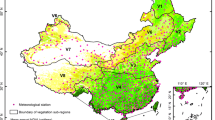Abstract
Quantifying climate-induced changes in vegetation patterns is essential to understanding land–climate interactions and ecosystem changes. In the present study, we estimated various distributional changes of vegetation under different climate-change scenarios in the 21st century. Both hypothetical scenarios and Hedley RCM scenarios show that the transitional vegetation types, such as shrubland and grassland, have higher sensitivity to climatic change compared to vegetation under extreme climatic conditions, such as the evergreen broadleaf forest or desert, barren lands. Mainly, the sensitive areas in China lie in the Tibetan Plateau, Yunnan-Guizhou Plateau, northeastern plain of China and eco-zones between different vegetations. As the temperature increases, mixed forests and deciduous broadleaf forests will shift towards northern China. Grassland, shrubland and wooded grassland will extend to southeastern China. The RCM-project climate changes generally have caused positive vegetation changes; vegetation cover will probably improve 19% relative to baseline, and the forest will expand to 8% relative to baseline, while the desert and bare ground will reduce by about 13%.









Similar content being viewed by others
References
Alex H, Prentice IC (1996) BIOME3: an equilibrium terrestrial biosphere model based on eco-physiological constraints, and competition among plant functional types. Glob Biogeochem Cycles 4(10):693–708
Bachelet B, Neilson PR, James ML, Raymond JD (2001) Climate change effects on vegetation distribution and carbon budget in the United States. Ecosystems 4:164–185
Betts RA, Cox PM, Lee SE, Woodward FI (1997) Contrasting physiological and structural vegetation feedbacks in climate change simulations. Nature 387:796–799
Cao M, Woodward FI (1998a) Dynamic responses of terrestrial ecosystem carbon cycling to global climate change. Nature 393:249–252
Cao M, Woodward FI (1998b) Net primary and ecosystem production and carbon stocks of terrestrial ecosystems and their responses to climate change. Glob Change Biol 4:185–198
Chen X, Zhang X, Li B (2003) The possible response of life zones in China under global climate change. Glob Planet Change 38:327–337
Gao Q, Yu M, Yang X (2000) An analysis of sensitivity of terrestrial ecosystems in China to climatic change using spatial simulation. Clim Change 47:373–400
Hansen MC, Defries RS, Townsgend JRG, Sohlberg R (2000) Global land cover classification at 1 km spatial resolution a classification tree approach. Int J Remote Sens 21(6/7):1331–1364
Hou X (1982) Vegetation map of China (1:4000000), SinoMaps Press, Beijing
Hurtt CG, Paul RM, Stephen WP, Simon AL (1998) Terrestrial models and global change: challenges for the future. Glob Change Biol 4:581–590
Jarvis PG, McNaughton KG (1986) Stomatal control of transpiration: scaling up from leaf to region. Adv Ecol Res 15:1–49
Kittel TGF, Rosenbloom NA, Painter TH, Schimel DS et al (1995) The VEMAP integrated database for modeling United States ecosystem/vegetation sensitivity to climate change. J Biogeogr 22:857–862
Neilson PR (1995) Model for predicting continental-scale vegetation distribution and water balance. Ecol Appl 5(2):362–385
Ni J, Sykes TM, Prentice IC, Cramer W (2000) Modeling the vegetation of China using the process-based equilibrium terrestrial biosphere model BIOME3. Glob Ecol Biogeogr 9:463–479
Peng C (2000) From static biogeographical model to dynamic global vegetation model: a global perspective on modeling vegetation dynamics. Ecol Modell 135:33–54
Prentice IC, Cramer W, Harrison SP et al (1993) A global biome model based on plant physiology and dominance, soil properties and climate. J Forest Biogeogr 19:117–134
Smith TM, Shugart HH, Bonan GB, Smith JB, Woodward FI (1992) Modeling the potential response of vegetation to global climate change. Adv Ecol Res 22:93–113
Woodward FI (1995) A global land primary productivity and phytogeography model. Glob Biogeochem Cycles 9(4):471–490
Yue T, Fan Z, Liu J (2005) Changes of major terrestrial ecosystems in China since 1960. Glob Planet Change. DOI 10.1016/j.gloplacha.2005.03.001
Zhang X, Yang D (1993) A study on climate–vegetation interaction in China: the ecological model for global change. Coenoses 8:105–119
Zhao M, Neilson PR, Yan X, Dong W (2002) Modeling the vegetation of China under changing climate. J Geogr Sci 57(1):28–38
Acknowledgments
This research was supported by the Chinese National Science Foundation.
Author information
Authors and Affiliations
Corresponding author
About this article
Cite this article
Yu, L., Cao, M. & Li, K. Climate-induced changes in the vegetation pattern of China in the 21st century. Ecol Res 21, 912–919 (2006). https://doi.org/10.1007/s11284-006-0042-8
Received:
Accepted:
Published:
Issue Date:
DOI: https://doi.org/10.1007/s11284-006-0042-8



